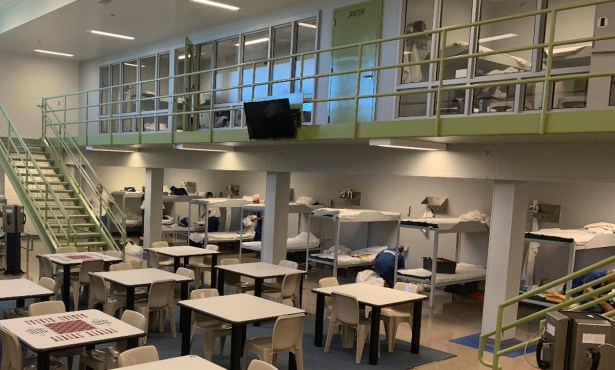No Open Seats Make for Tight Squeeze in Santa Barbara City Race
Of Blue Lines, Roundabouts, and Sustainability
Many political handicappers regard the upcoming November 6 Santa Barbara City Council election as mere foreplay for the main event: the anticipated showdown between councilmembers Iya Falcone and Helene Schneider over who will replace Marty Blum as Santa Barbara’s next mayor. Add to the mix that three incumbents will be forced from office two years hence because of term limits, and you have the makings of a very wide-open election. By contrast, this is the first year in which there will not be at least one open seat. Instead, we have three incumbents running to retain their office. This situation-and the obvious advantage enjoyed by the incumbents-has chased all but the very determined, or foolhardy, from the field.
The current City Council is a weird anomaly, a group of relatively like-minded people who often can’t get along. For the first time in history, the council is made up entirely of registered Democrats. Yet personal acrimony and political jealousies have made this among the prickliest of councils in many years. Despite this, though, much has been accomplished on this group’s watch. The past four years have seen the council’s approval of a living wage ordinance, unanimous support of the Cottage Hospital expansion and remodel, and a vote embracing plans to convert the former St. Francis Hospital into an affordable housing project for Cottage employees. After bitter negotiations, the council crafted a new contract with its police officers union. (Efforts by the firefighters union have fallen short so far.) And the council’s free-floating environmental good intentions have been channeled into an unusually focused and far-reaching policy to promote environmental sustainability in many forms.
Whoever gets elected to the council will confront the issue of gang violence, which has once again reasserted itself with lethal consequences. They’ll also grapple with traffic congestion, economic growth in the face of Santa Barbara’s “small-town spirit,” and the revamping of the city’s general plan in an effort to determine what kind of growth can occur, where it can happen, and in what densities.
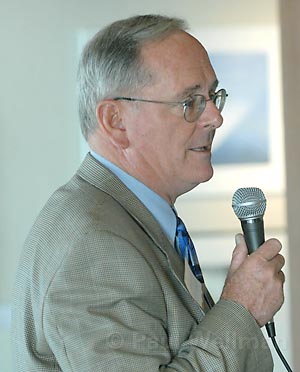
Brian Barnwell
Passionate, impulsive, and unpredictable, incumbent Brian Barnwell has emerged as one of the key swing votes in council deliberations. When architect and developer Barry Berkus proposed converting an old outer State Street motel into a high-end mixed-use project, for example, Barnwell surprised some friends in the business community by leading the charge against it. Barnwell blasted the project as way too big for the site. Afterward, Berkus and his proposal were toast. But when developer Mark Lee proposed building nearly 30 luxury homes on undeveloped land across from Las Positas Creek, Barnwell was equally vehement on behalf of the project and fought the environmentalists who opposed it. Little wonder that Barnwell would later muse, “I don’t know whom I appeal to. I really don’t.”
When Cottage Hospital proposed converting the former St. Francis Hospital into a major affordable housing development, Barnwell first angered neighborhood activists opposed to the plan by praising it as one of the best projects in city history. But in response to his new-found concern about global warming, he pushed Cottage administrators to include solar panels. Cottage refused, and threatened to pull its proposed project. Barnwell publicly accused Cottage of “arrogance,” then voted for the project. Afterward, he antagonized Cottage’s critics one last time by sending a congratulatory note to city staff for getting the St. Francis project approved-along with a box of doughnuts.
Barnwell is pushing to reduce the height of the buildings that can be approved within city limits from 60 feet to 40 or 45. The taller projects now moving through approval processes could harm the city’s character, he believes. Barnwell himself voted in favor of both large buildings going up on Chapala Street while he served on the Planning Commission-because one provided better creek setbacks and the other more affordable housing than city regulations required. But he’s not fazed by this apparent inconsistency. The intense pressure to approve projects once they’ve gotten so far along in the city’s planning process makes it “almost impossible to say no,” he said.
On the issue of sustainability, however, Barnwell has been notably consistent. Learning that nearly half the greenhouse gases were generated by heating buildings, Barnwell began pushing for changes in City Hall’s energy efficiency requirements for new buildings and additions. Barnwell pointed out that buildings produce half the greenhouse gases that contribute to global warming. “City governments approve these buildings,” Barnwell said. “It’s up to us to do something about it.”
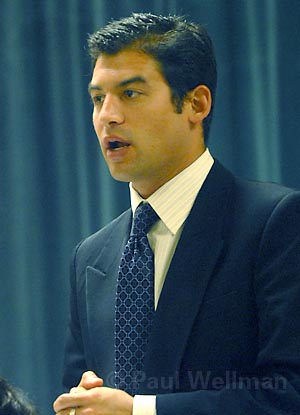
Das Williams
Das Williams understands some people don’t know what to make of him. He figures it starts with his multiethnic identity, evangelical faith, economic populism, and support for neighborhood activists dismissed by many affordable housing activists as “not-in-my-backyard” environmentalists. Superimposed on top of all this is an environmental agenda that combines the sensibilities of a homegrown Santa Barbara surfer with a degree from the Bren School of Environmental Science & Management.
But there’s something else, too. People sense Williams’s ambition in the brash energy he’s injected into City Hall’s traditional genteel ways. He’s been publicly willing to challenge city staff and he’s lobbied members of the Planning Commission, typically not done by councilmembers. He raised more than a few eyebrows when he campaigned- unsuccessfully-to defeat fellow councilmember Iya Falcone. And a year ago, Williams announced he was running for 2nd District Supervisor, resisting serious efforts by many within the Democratic Party establishment to talk him out of it. Janet Wolf won; Williams came in last. In the aftermath, Williams didn’t just lick his wounds; he went to work.
It’s all about getting results, Williams said. Early on, for example, he secured funding to stop sewage from flowing onto Eastside streets by holding up a sewer bond in the city’s finance committee until the extra money had been secured. Williams also led the charge to reduce pesticide use in parks.
Williams has banged the drum for more city-sponsored solar projects, and has supported both commuter rail and more funding for MTD to increase bus service. On affordable housing, Williams has worked consistently to hinder rental property owners from demolishing apartments and building new condos. He’s opposed height restrictions for buildings, which could deter affordable housing construction, and has supported the most intense development scenario for the proposed mixed-use transit village at MTD’s transit center. But Williams was also the only councilmember to vote against Cottage Hospital’s plans to provide affordable housing for its employees at the St. Francis site, arguing that a City Hall independent study should look into the feasibility of the scaled-back alternative supported by Cottage’s neighborhood critics. “A lot of people find it hard to say no to Cottage,” Williams said, “but in this case, I had to because the neighborhood was not given what it deserved.”
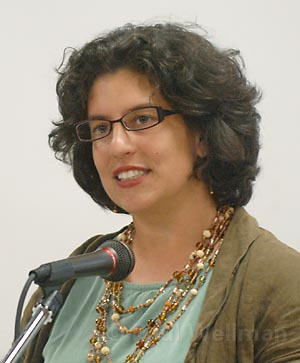
Helene Schneider
From the day she was sworn in four years ago, Helene Schneider has received almost uniformly high marks from council colleagues, city staff, and lobbyists of all stripes for the diligence, intelligence, and quiet determination of her approach. But the question confronting Schneider now is whether all that work building connections-“the yenta factor,” as she calls it-will get her over the top.
In recent months, Schneider found herself yanked somewhat unceremoniously from the background to the foreground by the controversy erupting over the Light Blue Line, which she helped spearhead. Ultimately, Schneider and the council strategically retreated on the global warming statement, even after she secured the funds from a private source-rather than City Hall-to pay for the art project. She’s denied reports that the proposal will resurface once the city elections are safely over. “We can’t bring back the same project at this point,” she said. “We can try something else-chalk instead of paint maybe-but the same thing wouldn’t be appropriate.”
On the council, Schneider has strongly supported the city’s current sustainability initiative. She spent more than two years immersing herself in the minutiae that went into the city’s recently approved Neighborhood Preservation Ordinance (NPO), designed to limit the proliferation of McMansions in modest residential neighborhoods like the Mesa. Despite strong misgivings by the Planning Commission and the Architectural Board of Review, the council voted 7-0 in favor of the NPO. “It was really important that we make a very clear statement on this one, and we did,” she said. Schneider has also taken on several long-term projects-vast in scope, regional in nature-that promise little by way of immediate pay-offs: commuter rail and chronic homelessness.
Likewise, Schneider has immersed herself in the details of housing policy, trying to change the city’s inclusionary housing ordinance to mitigate the loss of affordable housing that occurs when apartment owners convert their properties into condominiums. The city’s current ordinance requires developers to provide affordable housing if they’re building 10 or more units. Schneider is pushing to drop the threshold to two. “There are 28 projects in the pipeline that are less than 10 units,” she said. “If we don’t change our ordinance, all those are going to be luxury condos with nothing at all affordable built.”
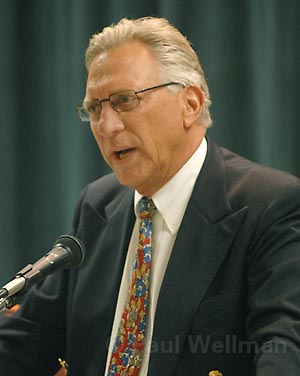
Frank Hotchkiss
Frank Hotchkiss never paid much attention to city politics until the City Council approved spending $12,000 on the Light Blue Line. Had he been on the council at the time, Hotchkiss is confident he could have changed the outcome. “I would have said it’s not good art, it’s not temporary, and it’s only one view and an extreme view at that,” he said. A man with the deep, imposing voice reflecting his former career as a professional actor, Hotchkiss has been selling real estate since moving to Santa Barbara nearly 10 years ago. Like many in the industry, Hotchkiss recoiled at the thought of the Light Blue Line. For properties on the wrong side of the line, he suggested, “It would have been like getting a bad termite report.” On global warming, Hotchkiss-who grew up in Darien, Connecticut, moved to Los Angeles to act, became a newspaper reporter, wrote a handful of novels, and moved into public relations before settling down into real estate-said the science is uncertain. He doesn’t doubt that warming is taking place, only that it’s necessarily bad. “The Northwest Passage is opening up,” he noted. “Is that a bad thing? It might be great for commerce.”
A self-described libertarian-leaning Republican, Hotchkiss has thrown himself into Santa Barbara’s cultural scene, organizing art exhibitions at his home on the Riviera. Although Hotchkiss served on an advisory committee in Pacific Palisades where he used to live, this marks his first time running for office. On the campaign trail, he’s blistered the City Council for threatening more stringent affordability requirements on developers. “They’re talking about requiring someone building two units-a duplex-to provide either one unit of affordable housing or pay an in-lieu fee,” he said. “That’s a terrible idea.” Like many of the challengers, Hotchkiss is convinced City Hall is pushing people to ditch their cars. “It’s a conscious effort to make it so people just can’t park,” he charged. As for gangs, he said, the City Council has been asleep at the wheel. “My message to gang members is simple,” he said. “Get out of gangs or get out of Santa Barbara.” The solution, he said, is not more gang intervention programs so much as better utilization of existing ones.
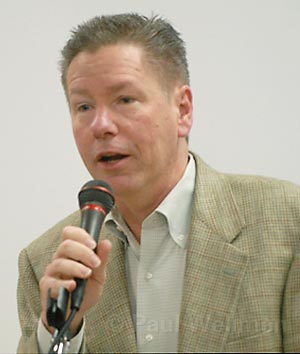
Dale Francisco
The most obvious way to go for any challenger running against entrenched incumbents with no open seats in sight is by going on the attack. “The one thing I know,” said Dale Francisco, a 54-year-old software engineer, “is I can do a better job than any of the three incumbents running.”
At forums, Francisco has displayed a penchant for getting under the incumbents’ skins, especially that of Das Williams. He claims City Hall has been taken over by anti-car idealists who will jeopardize public safety and flout common sense in their quest to push cars off the road. A lifelong Democrat who reregistered as a Republican after the 2002 election, Francisco said he was drawn into local politics after the controversy surrounding the traffic-calming devices installed throughout the upper Eastside. When the City Council voted to permanently install some of these this spring, Francisco claimed Public Works officials willfully ignored a former Fire Marshall’s reservations about the roundabouts. Only
when those reservations were made public, Francisco said, did Public Works agree to modify the plans. “Our council has an idea that automobiles are inherently evil and somehow we have to force people not to drive them,” he said. “It’s just not realistic.”
Francisco, who moved to Santa Barbara in 1979 and picked up degrees in computer science and English at UCSB, sees the automobile as the most democratic form of transportation yet devised. The real problems with the car, he said, are pollution and oil dependency, both of which he’s confident can be solved by technological advances.
Francisco supports Barnwell’s push to lower building heights; he also supports the NPO, which limits the size of new homes and additions. “I hate to admit it, but I agree with the NPO,” he said at a recent forum. He opposed Cottage’s housing project at St. Francis, calling it a “laudable goal” that unfairly burdened the surrounding neighbors with unacceptably high densities. He supports more cops on the streets and less homeless loitering at the downtown library. Francisco opposed the Light Blue Line. He’s also skeptical of global warming, saying the complexities of nature make it nearly impossible to devise accurate modeling systems. “I don’t think the science is anywhere near to being resolved,” he said.
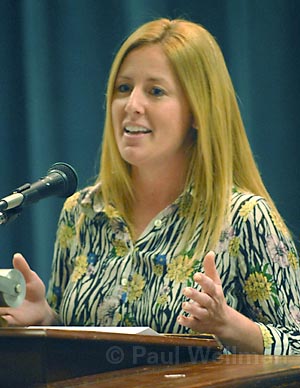
Michelle Giddens
Michelle Giddens is nothing if not persistent. First, she slogged through more than two years of tedious, agonizing hearings to determine whether City Hall would pass new rules guiding remodels in Santa Barbara. Armed with a 100-watt smile and a doggedly cheerful personality, Giddens packed planning workshops held on weekend days too beautiful for anyone to be indoors. Even so, the final vote did not go her way. “What I discovered is the whole public process is just a charade,” Giddens said. “The decision had already been made. I think the council has lost touch; it regards the public as a nuisance, an irritant.”
Giddens tapped into a constituency of young families and first-time home owners eager to develop their properties as they saw fit. “We wanted more flexibility,” Giddens explained. They didn’t get it. The City Council voted 7-0 earlier this year in favor of a new NPO that strictly regulates the size and height of additions.
Giddens was born in California, grew up in Texas, and moved to Santa Barbara nine years ago. After majoring in business administration, Giddens started her own business 12 years ago, selling air and water purification systems. The California Air Resources Board ruled the air purification system Giddens sells was a hazard to human health and has passed new requirements that will go into effect two years from now. Giddens said 49 states have no problem with her machines and she will continue selling and using them as long as legally possible. Mostly, though, she spends her time raising her three-year-old son.
Like challengers Francisco and Hotchkiss, Giddens opposed the Light Blue Line, mini-roundabouts, and the proposed rules tightening up the city’s inclusionary housing ordinance. On the latter, Giddens said the proposed changes would make it prohibitively expensive for developers to build entry-level condos, and said City Hall should do more to encourage rental housing than affordable home ownership. She also said City Hall should use the most modern and precise polling techniques to determine the will of the people when deciding how the General Plan should be amended. “The city shouldn’t be trying to get us out of our cars,” she said. “That’s our choice. The reality is that people drive. We need to solve today’s problems, not the problems of tomorrow.”
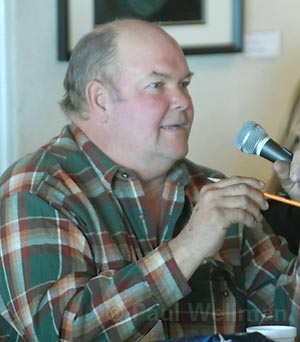
Bob Hansen
Bob Hansen knows he doesn’t have a prayer. After all, he’s run for City Council six or seven times and has never come close. But that doesn’t diminish the delight he takes in speaking his mind along the campaign trail. In years past, Hansen has inserted himself into City Council races to crack jokes and highlight such issues as the glaring lack of detox facilities (still unsolved) or the lack of public restrooms (now much improved).
This time around, Hansen is clamoring to convert the National Guard Armory between Santa Barbara Junior High School and Santa Barbara High School into a vocational trade school. “Lots of kids never graduate from high school,” he said. “What happens to them? If they had some hope of making $40 an hour, maybe gangs wouldn’t seem as appealing to them as they do.” On this score, Hansen is not just blowing smoke. City Hall has, in fact, been attempting to secure the National Guard Armory for at least eight years, but there’s been no real decision on what should be done with it if that effort were to succeed.
Hansen goes where few other candidates dare to follow. He has repeated his call for a Citizens Review Board for the city police department, arguing there was something seriously out of whack when two officers shot a man 17 times during Fiesta within such close proximity to thousands of people. An unabashed marijuana consumer, Hansen mocked the double standard existing between pot and booze. He said people should be able to purchase marijuana to relax-not just for the obviously phony medicinal pretext used by many of the medical marijuana dispensaries. “Come on, let’s be adults here,” he said. “What’s the difference between a martini and a joint?”
Despite the odds against him, Hansen said he’d love to be on the council. “Somebody has to say something different than all those cronies who get up there,” he said. He likes to joke that his political inspiration is Edmund O. Hansen, who was elected mayor in 1935 and tried to seize control of Santa Barbara’s Police Department. “I think he lasted six months,” Hansen said. “Then they got rid of him.”
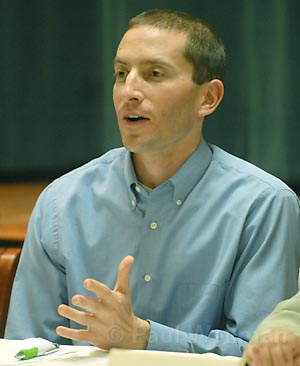
Dan Litten
An intriguing combination of libertarian and environmentalist, Dan Litten is focusing much of his ire on the gas-powered leaf blower, as he finds it inexcusable that City Hall does not enforce the 10-year-old law prohibiting their use. Worse yet, Litten said, the city parks crews often use them. “To see our own city violate it, that’s not right,” he said. The problem with the leaf blowers is not just the noise, Litten said, but the particulate matter they churn up and the greenhouse gases they emit. A two-stroke leaf blower can generate in one hour as much pollution as a car driven for 7,000 miles.
Litten grew up outside Albany, New York, and moved to Santa Barbara five years ago to serve his internship at Cottage Hospital. He’s since become a full-fledged doctor and decided to run for the council to highlight his concern that City Hall is failing the environment. “They’re doing a lot, but they could do more,” he said. Litten applauded efforts to reduce the amount of pesticides deployed at city parks but stressed the city could turn off air conditioners in summer months in city office buildings and use fans instead. And city workers should be allowed to dress appropriately to the actual weather rather than artificially modifying the “weather” to accommodate professional dress codes. To the extent possible, Litten said, city employees should ride bicycles. This includes police officers, who on bikes could not only help the environment but could also inculcate better relations between the police and the community.
As for the Light Blue Line, Litten said its sponsors should have made it a voluntary option for the affected property owners. As a libertarian, he said, he had problems with spending public funds on public art. “And calling it art is kind of a stretch,” he added.
Litten has been showing up at some of the community forums and has been setting up a card table at Saturday’s Farmers Market. “The truth is that local races aren’t that interesting to many people,” he said.


